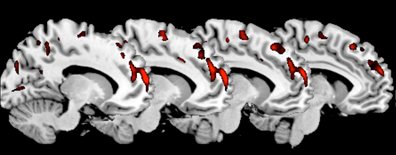Psychopathy linked to brain abnormalities
New research provides the strongest evidence to date that psychopathy is linked to specific structural abnormalities in the brain. The study, led by researchers at King’s College London Institute of Psychiatry (IoP) is the first to confirm that psychopathy is a distinct neuro-developmental sub-group of anti-social personality disorder (ASPD).
The study was funded by the National Institute for Health Research (NIHR) Biomedical Research Centre for Mental Health at the South London and Maudsley NHS Foundation Trust and the Institute of Psychiatry at King’s College London and published in Archives of General Psychiatry.
Most violent crimes are committed by a small group of persistent male offenders with ASPD. Approximately half of male prisoners in England and Wales will meet diagnostic criteria for ASPD. The majority of such men are not true psychopaths (ASPD-P). They are characterised by emotional instability, impulsivity and high levels of mood and anxiety disorders. They typically use aggression in a reactive way in response to a perceived threat or sense of frustration.
However, about one third of such men will meet additional diagnostic criteria for psychopathy (ASPD+P). They are characterised by a lack of empathy and remorse, and use aggression in a planned way to secure what they want (status, money etc.). Previous research has shown that psychopaths’ brains differ structurally from healthy brains, but until now, none have examined these differences within a population of violent offenders with ASPD.
Dr Nigel Blackwood from the IoP at King’s and lead author of the study says: ‘Using MRI scans we found that psychopaths had structural brain abnormalities in key areas of their ‘social brains’ compared to those who just had ASPD. This adds to behavioural and developmental evidence that psychopathy is an important subgroup of ASPD with a different neurobiological basis and different treatment needs’
‘There is a clear behavioural difference amongst those diagnosed with ASPD depending on whether or not they also have psychopathy. We describe those without psychopathy as ‘hot-headed’ and those with psychopathy as ‘cold-hearted’. The ‘cold-hearted’ psychopathic group begin offending earlier, engage in a broader range and greater density of offending behaviours, and respond less well to treatment programmes in adulthood, compared to the ‘hot-headed’ group. We now know that this behavioural difference corresponds to very specific structural brain abnormalities which underpin psychopathic behaviour, such as profound deficits in empathising with the distress of others.’
The researchers used Magnetic Resonance Imaging (MRI) to scan the brains of 44 violent adult male offenders diagnosed with Anti-Social Personality Disorder (ASPD). Crimes committed included murder, rape, attempted murder and grievous bodily harm. Of these, 17 met the diagnosis for psychopathy (ASPD+P) and 27 did not (ASPD-P). They also scanned the brains of 22 healthy non-offenders.
The study found that ASPD+P offenders displayed significantly reduced grey matter volumes in the anterior rostral prefrontal cortex and temporal poles compared to ASPD-P offenders and healthy non-offenders. These areas are important in understanding other people’s emotions and intentions and are activated when people think about moral behaviour. Damage to these areas is associated with impaired empathising with other people, poor response to fear and distress and a lack of ‘self-conscious’ emotions such as guilt or embarrassment.
Dr Blackwood explains: ‘Identifying and diagnosing this sub-group of violent offenders with brain scans has important implications for treatment. Those without the syndrome of psychopathy, and the associated structural brain damage, will benefit from cognitive and behavioural treatments. Optimal treatment for the group of psychopaths is much less clear at this stage.’
The research was funded by research grants from the Department of Health, the Ministry of Justice, the Psychiatry Research Trust and the NIHR Biomedical Research Centre at the South London and Maudsley NHS Foundation Trust and the Institute of Psychiatry, King’s College London.

Areas of reduced gray matter volume in the temporal pole (above) and medial prefrontal cortex (below) and areas of the brains of the psychopathic group of antisocial men (ASPD+P) compared to the non-psychopathic group of antisocial men (ASPD-P).

For full paper: Gregory, S. et al. ‘The Antisocial Brain: Psychopathy Matters – a structural MRI investigation of antisocial male offenders’, Archives of General Psychiatry – a JAMA Network publication (7th May 2012)
For more information, please contact Seil Collins, Press Officer, Institute of Psychiatry, email: seil.collins@kcl.ac.uk or tel: 0207 848 5377